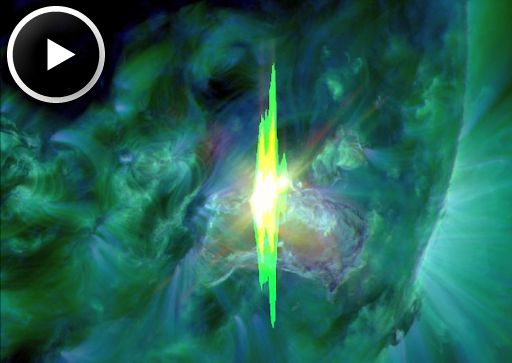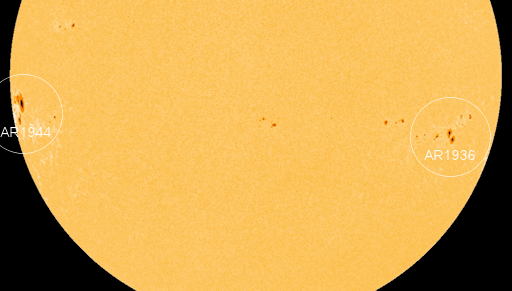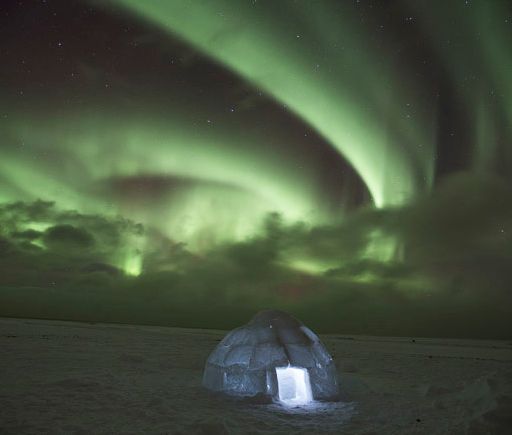SPACE WEATHER BALLOON, LANDED: On Jan. 1st, the students of Earth to Sky Calculus launched a "space weather balloon" to monitor the effects of solar activity on Earth's atmosphere. Lofted by approximately 200 cubic feet of helium, the balloon traveled to the stratosphere over the Sierra Nevada mountains of central California. After a 2.5 hour flight, the payload parachuted back to Earth in a wilderness area where students will recover it on Jan. 2nd. Payload contents included a high-energy radiation sensor, a cryogenic thermometer, and a pair of Hero3+ cameras. As far as we know, this is the first flight of GoPro's new "3+" adventure camera to the edge of space, so stay tuned for footage.
SOLAR ACTIVITY IS HIGH: 2014 began with a bang. At 18:54 UT on January 1st, big sunspot AR1936 erupted, producing a strong M9-class solar flare. NASA's Solar Dynamics Observatory captured the explosion's extreme ultraviolet flash:
The movie shows a dark filament of plasma racing away from the blast site, but most of the material fell back to the stellar surface. Nevertheless, the explosion did produce a CME that could deliver a glancing blow to Earth's magnetic field later this week. NOAA analysts are still evaluating this possibility.
The M9-flare of New Year's Day followed close on the heels of an M6-flare on New Year's Eve. Sunspot AR1936 produced both explosions. The New Year's Eve event produced a minor, slow-moving CME that is not expected to disturb Earth's magnetic field if and when it does arrive.
Sunspot AR1936 is active, but new sunspot AR1944 looks even more potent. The behemoth active region emerged over the sun's southeastern limb on Jan 1st:
Because of foreshortening near the sun's limb, the complexity of AR1944's magnetic field is still unknown. The sheer size of the sunspot, however, suggests it is capable of strong flares. The emergence of AR1944 combined with the ongoing activity from AR1936 has prompted NOAA forecasters to raise the odds of eruptions on Jan. 2nd to 70% for M-flares and 30% for X-flares. Solar flare alerts: text, voice.
Realtime Space Weather Photo Gallery
FIRST AURORAS OF 2014: A solar wind stream is buffeting Earth's magnetic field, sparking the first auroras of 2014. Tour guide Peter Rosén photographed the New Year's display from Abisko National Park in the Swedish Lapland:
"This was our first night at our new ice igloo camp in Abisko National Park--and what a night!" says Rosén. "Me, my 2 new photo guides Ylva and Anette, and 11 guests from all over the world got to see the most incredible auroras. And when Ylva Sarri started to sing a traditional Sámi jojk about the wind while we were sitting next to the fire, I think I was not the only one who experienced an almost religious feeling. I hope this is a good sign for the rest of 2014."
The second auroras of the New Year are likely tonight. NOAA forecasters estimate a 40% chance of polar geomagnetic storms on Jan. 2nd as the solar wind continues to blow. Aurora alerts: text, voice.

Solar wind
speed: 587.7 km/sec
density: 3.3 protons/cm3
explanation | more data
Updated: Today at 1546 UT
X-ray Solar Flares
6-hr max: C9 1226 UT Jan02
24-hr: M1 0233 UT Jan02
explanation | more data
Updated: Today at: 1500 UT
![]()
Daily Sun: 02 Jan 14
Sunspot AR1936 has a 'beta-gamma-delta' magnetic field that harbors energy for X-class solar flares. New sunspot AR1944 is a possible source of strong flares, too. Credit: SDO/HMI
![]()
Sunspot number: 106
What is the sunspot number?
Updated 02 Jan 2014
Spotless Days
Current Stretch: 0 days
2013 total: 0 days (0%)
2012 total: 0 days (0%)
2011 total: 2 days (<1%)
2010 total: 51 days (14%)
2009 total: 260 days (71%)
Since 2004: 821 days
Typical Solar Min: 486 days
Update 02 Jan 2014
The Radio Sun
10.7 cm flux: 145 sfu
explanation | more data
Updated 02 Jan 2014
![]()
Current Auroral Oval:
Switch to: Europe, USA, New Zealand, Antarctica
Credit: NOAA/POES
![]()
Planetary K-index
Now: Kp= 3 quiet
24-hr max: Kp= 4 unsettled
explanation | more data
Interplanetary Mag. Field
Btotal: 5.4 nT
Bz: 4.7 nT north
explanation | more data
Updated: Today at 1546 UT
![]()
Coronal Holes: 01 Jan 14
Solar wind flowing from the indicated coronal hole could reach Earth on Jan 2-4. Credit: SDO/AIA.







